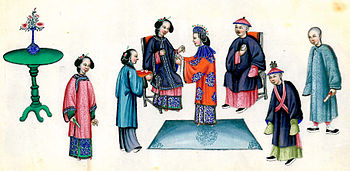
Traditional Chinese marriage (Chinese: 婚姻; pinyin: hūnyīn) is a ceremonial ritual within Chinese societies that involves not only a union between spouses but also a union between the two families of a man and a woman, sometimes established by pre-arrangement between families. Marriage and family are inextricably linked, which involves the interests of both families. Within Chinese culture, romantic love and monogamy were the norm for most citizens. Around the end of primitive society, traditional Chinese marriage rituals were formed, with deer skin betrothal in the Fuxi era, the appearance of the "meeting hall" during the Xia and Shang dynasties, and then in the Zhou dynasty, a complete set of marriage etiquette ("six rituals") gradually formed. The richness of this series of rituals proves the importance the ancients attached to marriage.[citation needed] In addition to the unique nature of the "three letters and six rituals",[citation needed] monogamy, remarriage and divorce in traditional Chinese marriage culture are also distinctive.